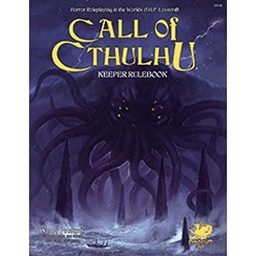Call of Cthulhu 7th Edition Keeper Rulebook Chapter 2: H. P. Lovecraft
Friday , 28, April 2017 Appendix N 10 Comments This chapter contains an absolutely first rate retrospective on Lovecraft’s works. And when the authors write that “Lovecraft is recognized as being one of the foremost horror writers of the twentieth century,” there are no ifs, buts, caveats, or footnotes. It is absolutely refreshing to have this stated so plainly. And I have not seen a better summary of his work and impact anywhere.
This chapter contains an absolutely first rate retrospective on Lovecraft’s works. And when the authors write that “Lovecraft is recognized as being one of the foremost horror writers of the twentieth century,” there are no ifs, buts, caveats, or footnotes. It is absolutely refreshing to have this stated so plainly. And I have not seen a better summary of his work and impact anywhere.
This cleared up several questions I had from reading the Mythos stories myself for Appendix N and which I had not stumbled across in the time since delving into these topics on my own. For instance, I could not figure out why it was that Lovecraft collaborated with Zealia Bishop and Hazel Heald. And given that I’d actually taken some criticism for treating these particular stories as first class examples of Lovecraft’s oeuvre, I really wanted to know more!
According to the designers, Lovecraft was uncompromising in his “gentleman’s desire to reach for aesthetic goals unfettered by commercial demands.” He did about ninety percent of the work on these stories, developing complete stories from little more than “a few root ideas” supplied by the people that would end up receiving the credit at the time. Surprisingly, these stories were “quickly accepted” by Farnsworth Wright for Weird Tales at a time when Lovecraft’s stories were being consistently rejected.
There’s a fact that has not been mentioned in the tedious and ubiquitous discussions on “women in science fiction”: one of the most imposing figures in the fantasy and science fiction canon was nearly unpublishable in his day unless he, in effect, posed as a female author. No wonder I took heat for shedding light on this corner of science fiction and fantasy history!
One of the most persistent discussion points on Appendix N is “what is the Appendix N of Appendix N?!” Here the game designers provide an engrossing breakdown of Lovecraft’s collaborators and influences. The overlap between the work of Robert E. Howard, Clark Ashton Smith, and Robert Bloch at the early stages of the Mythos’s development. August Derleth’s place within the ranks of “Lovecraftian” authors is of course hotly debated. You hear far less about creators like Ambrose Bierce, Edgar Allan Poe, Arthur Machen, Robert W. Chambers, Lord Dunsany, and Algernon Blackwood. The map provided here of these various connections and influences is absolutely invaluable to fans of classic “weird” fiction.
I was very happy to see that “the designers have omitted classifying Mythos races into the divisions of Servitor and Independent (greater and lesser varieties).” This is the take on Lovecraftian fiction that infuses tabletop games such as Klaus Westerhoff’s excellent The Stars Are Right. It’s a top flight game, no doubt, and excellent fun… but this sort of premise is nothing like Lovecraft’s original stories. The designers are absolutely correct that “such classifications tend to diminish the alien quality of these beings, stripping away some of the unknowable quality which HPL bequeathed them,”
Similarly, I was extremely harsh in my critique of August Derleth’s The Trail of Cthulhu and took flak from Mythos fans that thought I was diminishing him unfairly when he is arguable responsible for Lovecraft even being in print at all today. It’s very gratifying to find myself in the same company as Sandy Peterson who excised the Derlethian heresies from this venerable game. The authors note, “carrying Elder Signs around like crucifixes and holy water and always having the white-hat Elder Gods in the background, ready to save one’s bacon if things get too bad, greatly weakens the original horror of the bleak uncaring universe, to which mankind is left naked and defenseless.”
Exactly!
I couldn’t have put it better it better myself. This game does not just exude an exacting faithfulness to the source material. The designers have made exactly the sort of creative choices that I have already advocated for.
This is awesome.
That’s interesting that they have excised the Derlethian hierarchies as all previous editions have used them. That’s encouraging. I might eventually have to obtain this edition.
We are basically at this point where it is more than surprising to read anything concerning Lovecraft’s person in some Mythos related release, be it introduction or bio or anything, where author doesn’t engage in ye olde ritual mud slinging.
Reminds me how, almost every time that Joshi is touching on some recent anthology on his blog, he encounters at least one new “-ism” attached to HPL.
So, props to author of that retrospective.
Anyone read John Michael Greer’s The Weird of Hali? Kind of pricy for me, but it looks good.
The passage “carrying Elder Signs around like crucifixes and holy water and always having the white-hat Elder Gods in the background, ready to save one’s bacon if things get too bad, greatly weakens the original horror of the bleak uncaring universe, to which mankind is left naked and defenseless” has been in Call of Cthulhu since at least the fifth edition rules in the early 1990s, as a side note. I vividly remember reading it then and ignoring it totally in my games. We may have put an Elder Sign on a congreve rocket, but it’s been a while.